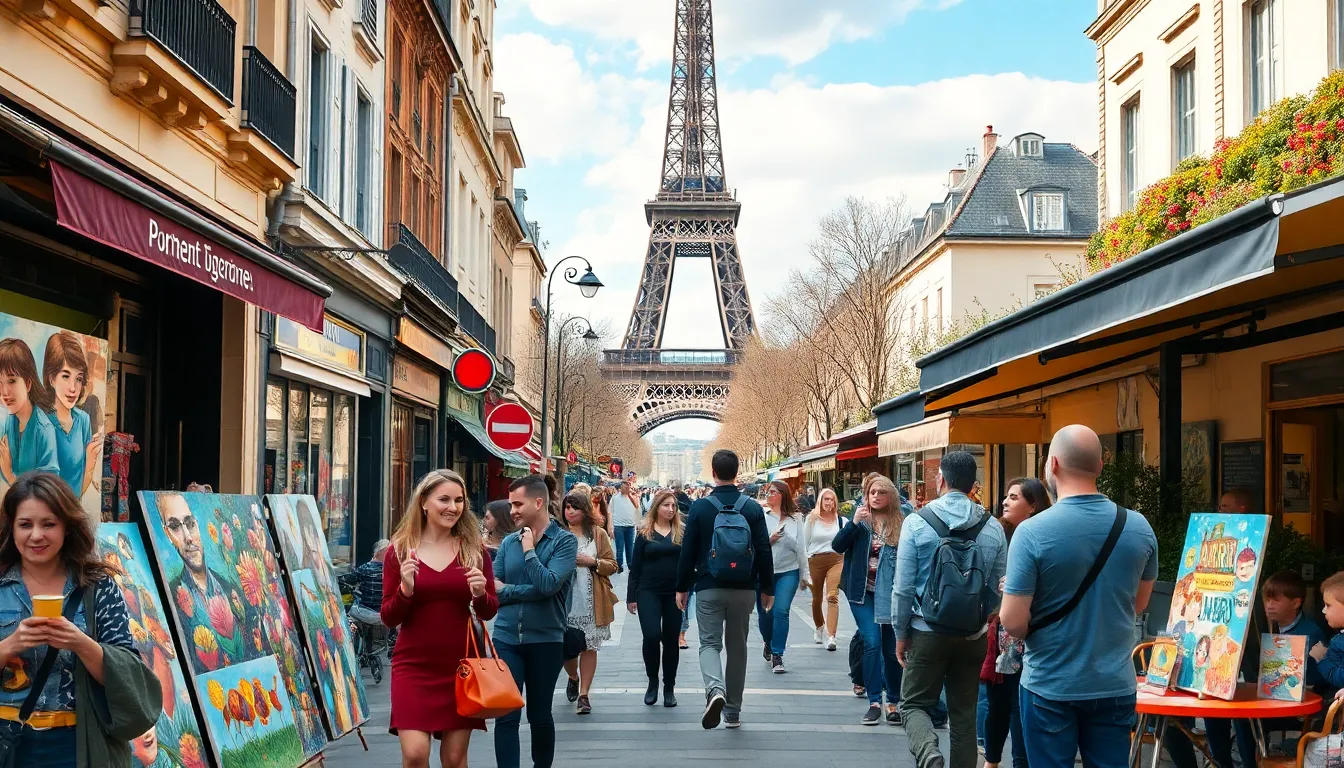Table of Contents
ToggleEvery year, millions of travelers pack their bags, armed with cameras and wanderlust, ready to explore the world. But one question always pops up: which country lures the most tourists? Spoiler alert: it’s not where you’d find the best pizza or the most breathtaking beaches.
Overview of Global Tourism Trends
Global tourism trends reveal significant patterns in travel behavior and destination popularity. According to the United Nations World Tourism Organization (UNWTO), international tourist arrivals reached 1.5 billion in 2019, showcasing a steady growth in travel demand. Countries that attract the most tourists typically offer unique experiences, cultural richness, and diverse landscapes.
France consistently ranks as the top destination for international visitors. It welcomed 89 million tourists in 2019, drawn to its iconic landmarks, art, and culinary offerings. Spain follows closely, with 83 million arrivals, thanks to its vibrant cities and beautiful coastline. The United States also attracts millions, boasting 79 million visitors who explore its national parks, cities, and historical sites.
Emerging destinations are gaining attention too. Countries like Thailand and Mexico saw substantial increases in tourist numbers, with 39 million and 45 million arrivals, respectively. Their favorable climates and rich cultures contribute to their rising popularity. Additionally, destinations in the Middle East are increasingly attracting visitors, with places like Dubai welcoming 16 million tourists in 2019.
Travel trends indicate changing preferences among travelers. Adventure tourism and eco-tourism are on the rise, with more seeking authentic and sustainable experiences. As countries adapt to these shifts, they enhance their appeal by showcasing local cultures and natural wonders.
Data on tourism highlights the importance of infrastructure and accessibility. Well-developed transportation networks and accommodations significantly impact a country’s ability to attract visitors. Investing in tourism infrastructure can lead to increased economic benefits and job creation, making it vital for countries to prioritize this sector.
Top Countries by Tourist Arrivals

Countries vary significantly in tourist attraction levels. France leads the world by welcoming 89 million visitors in 2019. Spain follows closely with 83 million tourists, while the United States attracts 79 million. Emerging contenders such as Mexico and Thailand draw 45 million and 39 million tourists, respectively. These numbers reflect diverse travel trends and preferences.
Country Rankings
France consistently ranks as the top global tourist destination. Spain holds second place, making it a favorite among travelers. The United States captures the third position, offering a vast array of experiences. Consistent growth in arrivals indicates travelers’ growing interests. Other countries like Mexico and Thailand also gain popularity, attracting millions seeking unique experiences.
Factors Influencing Rankings
Infrastructure contributes significantly to tourist arrivals. Countries with well-developed transport networks and accommodations attract more visitors. Accessibility plays a vital role in determining destination popularity. Marketing strategies also influence travelers’ choices. Unique cultural experiences and natural landscapes enhance a country’s appeal. Factors like safety and political stability further affect tourists’ decisions.
Popular Attractions in Leading Countries
Tourists flock to various countries for unique experiences and iconic sights. Each destination boasts attractions that captivate millions every year.
Iconic Landmarks
France features the Eiffel Tower, a symbol of romance and architecture, drawing millions annually. Spain’s Sagrada Familia stands as an architectural marvel, drawing admirers of Gaudí’s artistry. The Statue of Liberty in the United States welcomes visitors, symbolizing freedom and opportunity. Thailand’s stunning beaches, like those in Phuket, attract sun-seekers looking for relaxation. Mexico’s Chichen Itza, a UNESCO World Heritage site, showcases rich history and impressive Mayan ruins. These landmarks serve as focal points for tourists, enhancing each country’s draw.
Cultural Experiences
Cultural immersions enhance travel experiences in leading countries. In France, local cuisine like croissants and French wine offers authentic taste exploration. Spanish flamenco dance captivates audiences and showcases regional heritage, while American cities like New Orleans present vibrant jazz scenes. Thai cooking classes allow visitors to learn culinary techniques and traditional recipes. Mexico’s rich traditions come alive during festivals, engaging travelers in local customs. Such cultural experiences enrich the travel journey, making every visit memorable.
Economic Impact of Tourism
Tourism significantly impacts economies worldwide, contributing billions in revenue and creating jobs.
Revenue Generation
Countries rely on tourist spending to bolster their economies. France earned approximately €57 billion from tourism in 2019, while Spain generated €92 billion. The influx of visitors leads to increased sales in hospitality sectors, retail businesses, and entertainment venues. Tax revenues also rise as tourists spend on accommodations, meals, and attractions. Beyond direct spending, tourism stimulates investments in infrastructure, promoting further economic developments. Local businesses flourish, benefiting from the demand for souvenirs, local foods, and cultural experiences.
Job Creation
Tourism is a major driver of employment. France employed over 2 million people in tourism-related jobs by 2019; Spain followed closely with about 1.5 million. Positions in hotels, restaurants, and transportation services account for a significant portion of the workforce. Seasonal jobs often arise due to the peak tourist seasons, providing opportunities for many. Economic stability often results as communities near popular attractions grow and expand to support visitor needs. When tourists arrive, the demand fosters entrepreneurial ventures and innovative services within local populations.
Challenges Facing Tourist-Heavy Countries
Countries attracting high numbers of tourists encounter various challenges. Managing these issues effectively becomes crucial for sustainable tourism growth.
Environmental Concerns
Tourist-heavy countries face significant environmental concerns. Ecosystems often suffer due to the high volume of visitors. Pollution from increased transportation, waste generation, and resource depletion negatively impacts natural habitats. France, for instance, sees millions visiting the French Riviera, which strains marine life and coastal areas. Sustainability initiatives are essential to limit tourist footprints while protecting biodiversity. Some nations implement measures like environmental awareness campaigns and limit access to sensitive sites. These efforts help balance tourism with environmental conservation.
Overcrowding Issues
Overcrowding issues frequently arise in popular destinations. Places like Spain’s Barcelona experience congestion due to millions of tourists annually, leading to declining experiences for both visitors and locals. As public transportation struggles to accommodate increased demand, residents often voice their frustrations. Governments can respond with infrastructure improvements and tourist caps during peak seasons. These measures aim to distribute tourist traffic more evenly across regions. Limiting visitor numbers at specific sites ensures safety and enhances overall satisfaction while preserving cultural integrity.
Future of Global Tourism
Global tourism faces exciting transformations as travelers seek new experiences and destinations. Countries that harness these shifts can attract a growing number of visitors.
Emerging Destinations
Emerging destinations show increasing appeal, with countries like Vietnam, Portugal, and Colombia gaining traction. Vietnam draws tourists with its rich history and stunning landscapes, while Portugal captivates travelers through its beautiful coastline and vibrant cities. Colombia stands out for its diverse culture and welcoming locals, attracting interest from adventurous tourists. These countries offer authentic experiences that resonate with the desire for unique travel opportunities. In addition, according to recent UNWTO data, tourist arrivals in emerging destinations have surged by 25% since 2019, indicating their rising prominence on the global stage.
Changing Travel Preferences
Changing travel preferences reflect a stronger interest in sustainability and experiential travel. Today’s travelers actively seek eco-friendly options along with opportunities to connect with local cultures. Adventure tourism has seen substantial growth, allowing explorers to engage in activities such as hiking, zip-lining, and wildlife safaris. Seeking authentic culinary experiences, many tourists prioritize local cuisine and food tours over traditional sightseeing. Moreover, wellness tourism has risen in popularity, with people gravitating towards retreats that promote health and relaxation. These evolving preferences direct how destinations tailor offers to meet modern travelers’ expectations.
The landscape of global tourism continues to evolve as countries adapt to changing traveler preferences. While France remains the leading destination for international visitors, emerging countries are capturing attention with unique offerings and experiences. The shift toward sustainable and authentic travel highlights the importance of infrastructure and cultural connections in attracting tourists.
As destinations strive to balance growth with environmental responsibility, the future of tourism looks promising. Travelers are increasingly prioritizing experiences that resonate with their values, pushing countries to innovate and diversify their tourism strategies. This dynamic environment ensures that the quest for the most popular tourist destination will remain an intriguing topic for years to come.










